Digitally-based renaissance Headless ecommerce systems are a market revolution, dominating the current retailer transformation. With greater business needs to have increased flexibility, scalability, and personalisation in their online stores, the monolithic ecommerce products are becoming less attractive as businesses replace strategies with more adaptable solutions that are API first. Headless ecommerce is the future of ecommerce that will help companies bring high-level customer experiences at scale and still be operationally efficient.
With the current competitive business environment, the choice of a proper headless ecommerce system can lead to successful business or survival alone. These frameworks provide never seen flexibility to tailor frontends combined with the use of powerful backend capabilities. As more B2C and B2B companies are shifting towards building a headless ecommerce platform, totaling to approximately two-thirds of B2C and B2B corporations, it is crucial more than ever before to comprehend your possibilities.
This is a guide to the best 10 headless ecommerce platforms in 2025 which presents a detailed breakdown of the platforms and gives an insight into what they make available and how and why this can be utilized. So, whether you are a new business that aims to move quickly or a large company that wants to modernize your digital commerce system, this guide can assist, as you make the informed decision regarding the most appropriate headless ecommerce platform that will serve your business purposes.
What is a Headless Ecommerce Platform?
A headless ecommerce system is an ecommerce solution in which the front end presentation layer (the “head”) is separated from the backend business logic. This is in contrast to the conventional ecommerce sites, where the frontend and backend are very closely integrated to one another, whereas in headless ecommerce platforms, API-first building imparts the isolation of these aspects.
This type of architecture enables the businesses to operate their product catalog, availability, orders, and customer data via a powerful backend system with all freedom of creating whatever they want on the front side. APIs also allow the backend to interrelate with diverse frontends, so businesses can provide commerce experiences that have the same level of consistency across websites, mobile applications, social media, Internet of Things devices and other digital channels.
The headless ecommerce systems are especially useful among the businesses that have special user experience requirements, have a variety of operating channels, or that must connect to intricate pre-existing systems. These platforms allow faster cycles of development, less effort in maintaining the code, and more expenses in incorporating the latest technology and market trends since they allow a clear delineation between the backend and the frontend.
Benefits of Headless Ecommerce
- Enhanced Flexibility and Customization: Headless ecommerce lets you have as much freedom as you want to deliver bespoke front-ends without the limitations of the backend.
- Improved Performance and Speed: Intelligent loading and delivery of content leads to an improvement in loading times and user experiences due to optimal lightweight frontends.
- Omnichannel Commerce Capabilities: Provide a single user experience with websites, mobile apps, social media and IoT.
- Faster Time-to-Market: Frontend and backend can be developed independently in development teams, thus speeding up product releases and feature deployment.
- Better Scalability: Grow frontend and backend components separately using the traffic needs and business expansion.
- Future-Proof Architecture: Easily adopt new technologies and integrations without major platform overhauls or disruptions.
Top 10 Headless Ecommerce Platforms in 2025
1. Shopify Plus
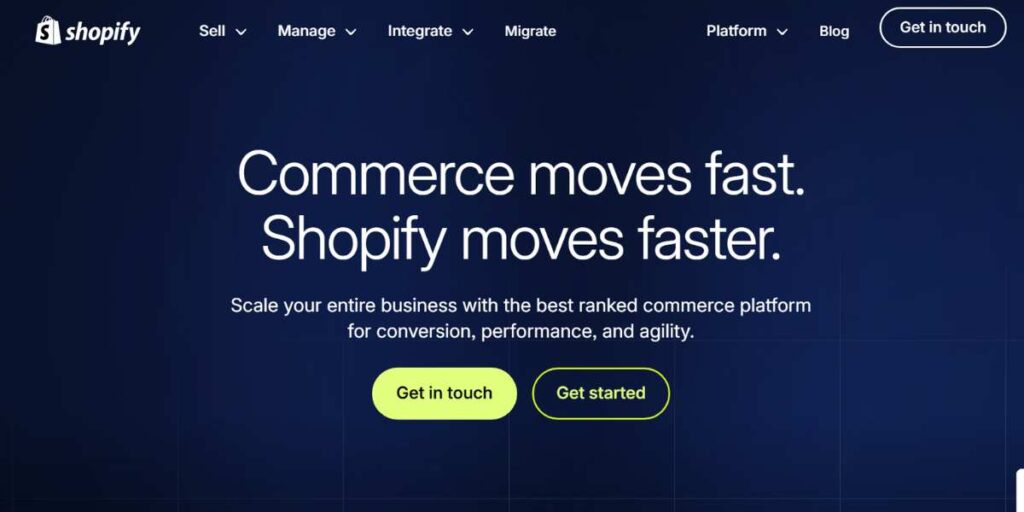
Shopify Plus is also one of the most popular headless ecommerce platforms that allows someone to deploy headless enterprises merely using React. Shopify Plus was initially a conventional platform serving the needs of basic business and evolved into a platform of complex international business with top-notch workflow automation and ongoing innovation. Having more than 100 product releases within a period of six months, this platform maintains sign of its commitment to keeping abreast of market trends.
The platform has broken new grounds in offering high-performance solutions to the firms with rapidly growing needs, bringing with them smooth-scaling abilities and a wide range of customization capabilities.
Core Features:
- High-speed performance with global CDN and 99.99% uptime guarantee
- Integrated AR, video, and 3D product catalog capabilities
- Advanced workflow automation across stores and applications
- Unlimited SKU support for global brands
- Comprehensive B2B features including custom pricing and personalized storefronts
Used by: Nike, Gymshark, Allbirds, Tesla, and thousands of other enterprise brands
Pricing: Starting at $2,300 per month for 3-year terms, with custom pricing for complex businesses
Website: http://shopify.com/plus
2. BigCommerce
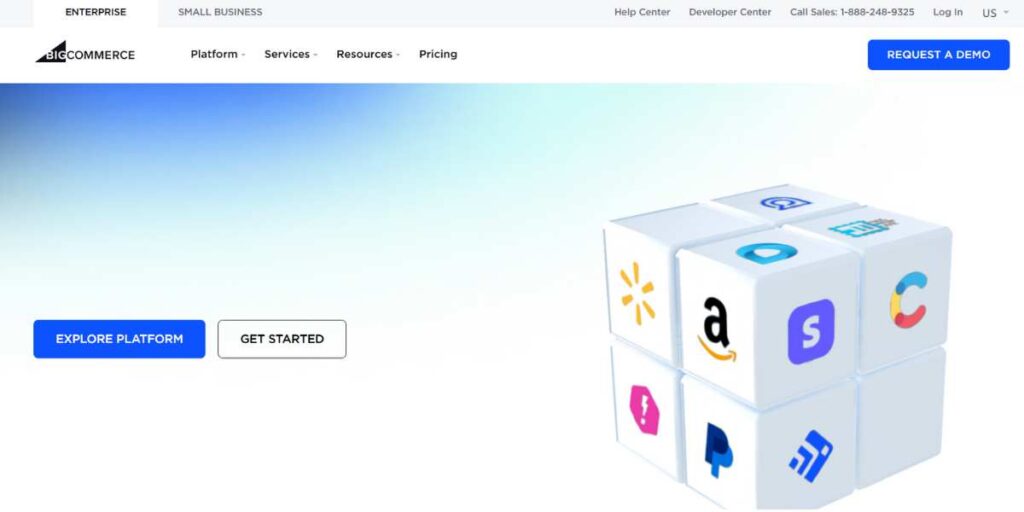
BigCommerce has become a top headless ecommerce platform that enables enterprises to implement a currently-primed commercial commerce. The platform has got full headless and composable functionalities, with new AI breakthroughs and multi-everything capability. BigCommerce does the best in offering the right tools so that establishments can operate various brands, shopfront, and stores within one dashboard.
The open API structure supports integration with third-party services to integrate with the platform easily because the open API architecture is the primary reason a large number of business implement the platform in their processes due to the complexity of their operations.
Core Features:
- Advanced AI capabilities including predictive analytics and semantic search
- Visual page builder with drag-and-drop merchandising tools
- Multi-storefront management from single dashboard
- Comprehensive B2B features with bulk ordering and custom catalogs
- Native SEO tools and mobile optimization features
Used by: Skullcandy, Ben & Jerry’s, Toyota, and various enterprise retailers
Pricing: Basic ($39/month) to Enterprise ($1,000+/month) based on annual sales volume
Website: http://bigcommerce.com
3. Adobe Commerce (Magento)
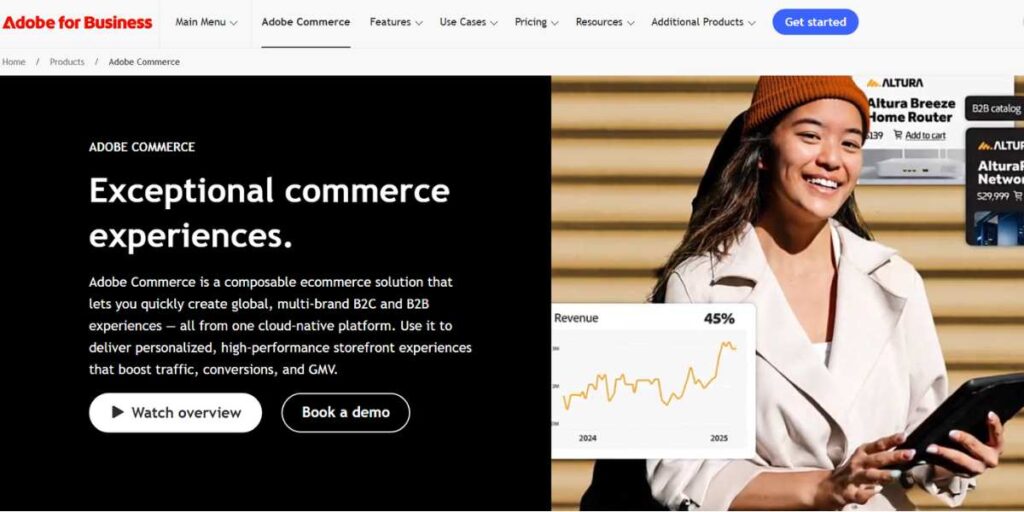
Adobe Commerce (previously Magento) is one of the most potent headless ecommerce platforms on the market suitable to use by an enterprise business. Adobe Commerce is also based on the flexibility and scalability so that they can be installed as both the traditional and headless solutions according to the business requirement where the business has the option to choose according to their technical needs.
The platform makes use of the full scope of AI that Adobe offers through Adobe Sensei GenAI which offers smarter workflows and individualized customer experiences. Adobe Commerce, with more than 100 inbuilt business intelligence reports and vast merchandising tools, supports business with complex analytics and the need to identify and maintain intricate customization functions.
Core Features:
- Adobe Sensei GenAI for intelligent workflows and personalization
- Advanced merchandising tools with AI-driven recommendations
- Extensive reporting capabilities with 100+ built-in reports
- App Builder for custom integrations and experiences
- Native B2B capabilities with shared catalogs and advanced pricing
Used by: Coca-Cola, Ford, Nestle, and major global enterprises
Pricing: Starting at $24,000 annually for licensed versions, with free open-source option available
Website: http://business.adobe.com/products/magento
4. Commercetools
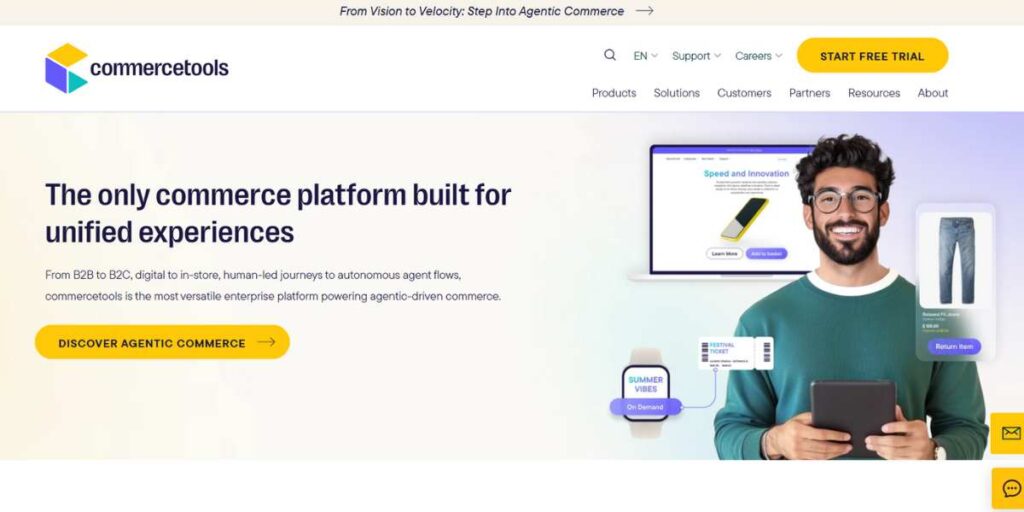
Being one of the first players in the headless ecommerce platforms market, commercetools has been preserving its top position in the industry due to never-ending innovation and an actual composable MACH architecture. Its platform takes advantage of microservice to bring unparalleled flexibility with businesses able to iterate and innovate on time.
Having more than 200 updates on platforms and releases each year, commercetools proves to be an immensely active company determined to remain on the cutting edge of technological advancements in ecommerce. Foundry solution on the platform offers pre-composed alternatives to speed up deployment and Frontend-as-a-service (FEaaS) allows the frontend development to be simplified.
Core Features:
- Composable MACH architecture with microservices flexibility
- commercetools Foundry for rapid deployment
- Frontend-as-a-Service (FEaaS) development environment
- Extensive API library with 300+ APIs
- Customizable B2B features for wholesalers and marketplaces
Used by: Audi, Danone, Sunrise, and other major enterprise brands
Pricing: Custom pricing averaging around $45,000 annually
Website: http://commercetools.com
5. Elastic Path
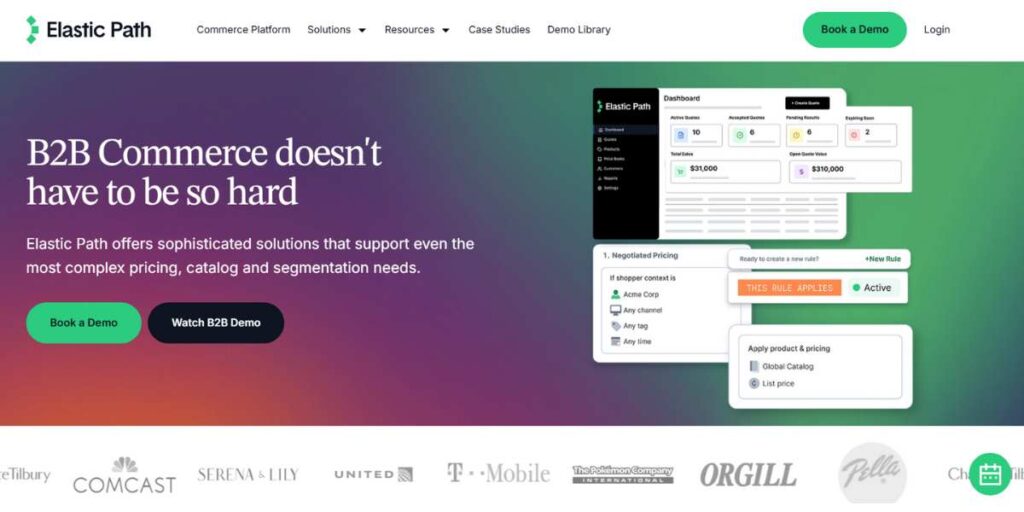
Elastic Path has been becoming an innovative headless ecommerce platform oriented on bringing composable commerce to any business. The platform is built on a potent API-first platform and user-friendly no-code app, closing the market gap between on-hand technical ability and be easy to approach. The Studio solution allows fast storefront development without code creation and the Product Experience Manager contains an integrated PIM and a product catalog. Other headless ecommerce platforms cannot compete with the platform in terms of subscription management through unique mechanism as well as in terms of the smart Composer tool to manage integration.
Core Features:
- Studio no-code tool for rapid storefront creation
- Integrated Product Experience Manager with unlimited catalogs
- Advanced subscription management capabilities
- Intelligent Composer for low-code integrations
- Comprehensive B2B features with role-based access
Used by: Various mid-market and enterprise B2B businesses
Pricing: Custom pricing with free trial available
Website: http://elasticpath.com
6. Salesforce Commerce Cloud
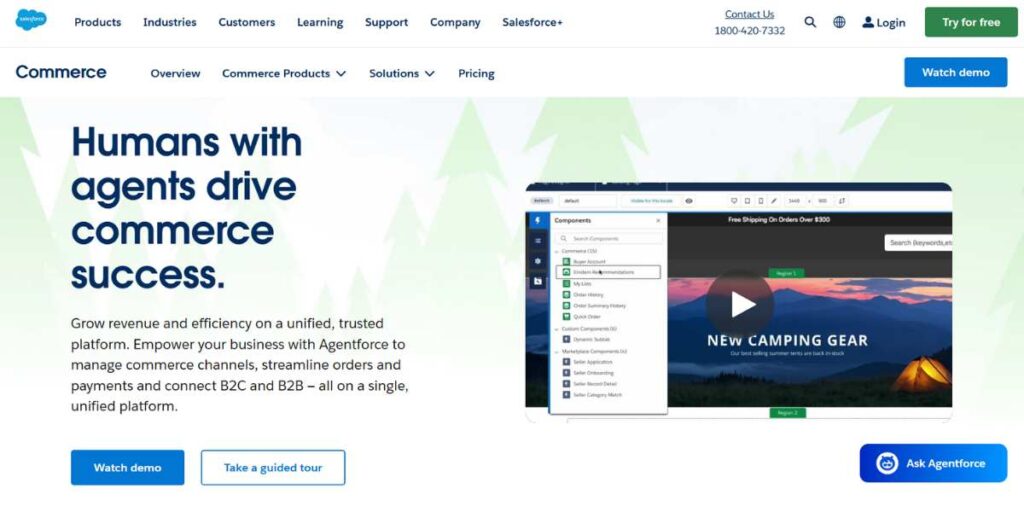
One of the headless ecommerce engines that is packaged with the complex Salesforce Customer Success Platform is Salesforce Commerce Cloud. This single commerce solution can be implemented in a traditional model and it can be fully headless with businesses deciding on the model they want to use to implement the same. Advanced personalization and predictive analytics are provided by integration of the platform with Salesforce AI functionality in Einstein 1.
Salesforce Commerce Cloud enables delivering of omnichannel experiences and integrating commerce functionality with CRM, marketing, and service closely. Additional new functionalities of Unified Commerce on the platform connect B2B and B2C, which are particularly convenient to the business that operates in multiple sectors of the market simultaneously.
Core Features:
- Fortified with Einstein 1 AI for personalization and predictive analytics
- Support for B2B and B2C unified commerce operations
- Composable PWA storefront capabilities
- Deep integration with Salesforce ecosystem
- Order management, payments, and fulfillment capabilities
Used by: Adidas, Puma, Under Armour, and major global retailers
Pricing: Custom pricing based on gross merchandise value
Website: https://www.salesforce.com/in/commerce/
7. VTEX Commerce Platform
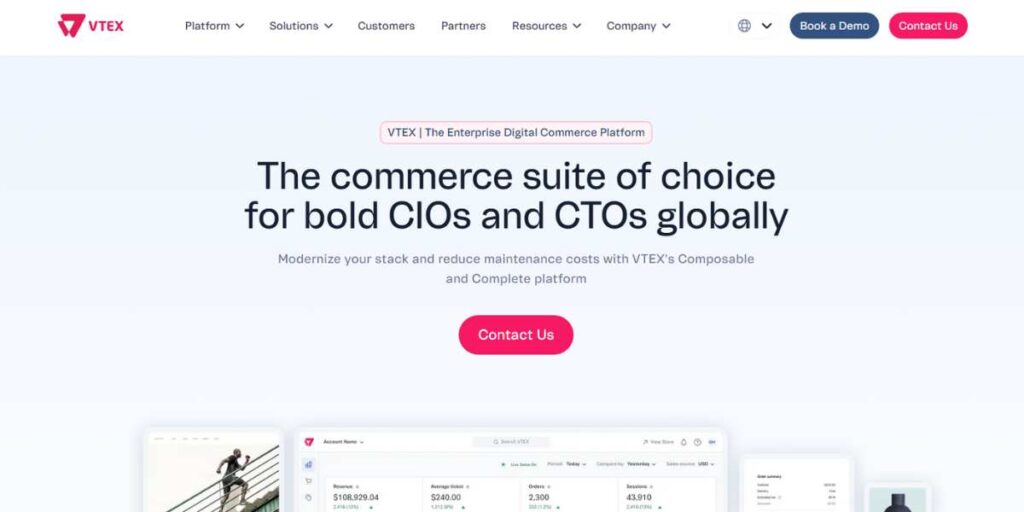
The visionary leader has been VTEX that has fast-tracked itself to the top of headless ecommerce platforms in the industry, including a one-stop-solution package of ecommerce and marketplace, and order management functions. According to MACH architecture VTEX provides B2B and B2C commerce solutions that present innovative features like Live shopping and collaboration commerce tools.
The platform also has the VTEX IO development environment where development is in quite a few pieces of fragments and themes that are already prepared which saves a lot of time and complexity of the development process. That the company can enable a company to combine a traditional e-commerce business and add marketplace capability, is what makes VTEX even more tempting to other companies with growth potential.
Core Features:
- VTEX IO low-code development platform
- Collaborative Commerce combining ecommerce and marketplace
- Innovative Live Shopping capabilities
- No-code CMS integration
- Comprehensive B2B features with bulk ordering and quotes
Used by: Coca-Cola, Walmart, and various global brands
Pricing: Custom pricing tailored to individual business needs
Website: http://vtex.com
8. Spryker
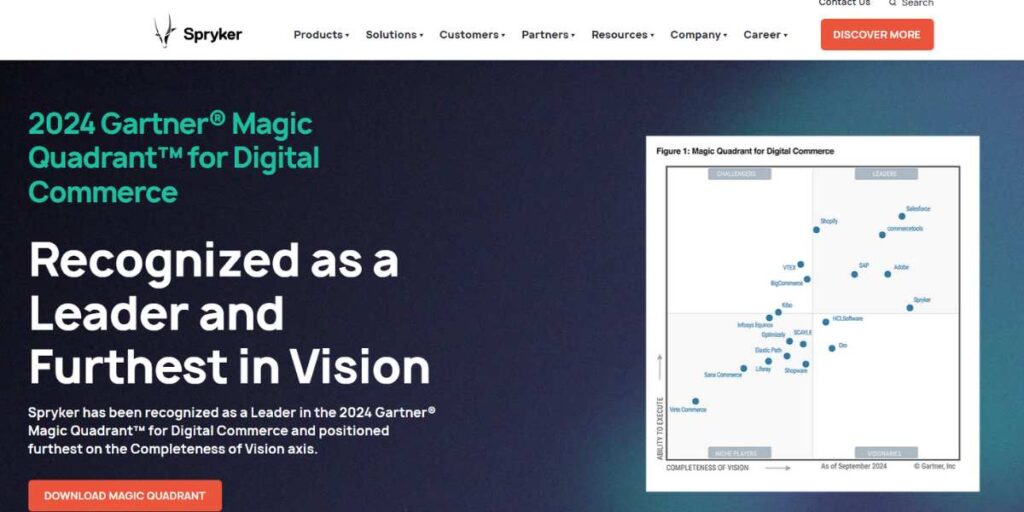
Spryker is a next-generation representation of headless ecommerce software on which B2B, marketplace, and direct-to-customer businesses are mainly carried out. Its fully composable platform allows businesses to develop heavily customizable solutions that go across traditional ecommerce to IoT commerce and integration with voice assistants.
The modularity of Spryker enables business to only take the modules that they require, which brings down the technical complexities and costs. The special features of the platform in terms of IoT trade such as the aid of voice aids and smart devices make the platform a leader of the next-generation trade experiences.
Core Features:
- Fully composable architecture with modular components
- IoT commerce capabilities for voice assistants and smart devices
- Integrated marketplace development tools
- Unified Commerce with CRM, PIM, and CMS capabilities
- Advanced B2B features with custom pricing and catalogs
Used by: Various enterprise B2B businesses and global retailers
Pricing: Custom pricing for Commerce Cloud OS and B2B Suite
Website: http://spryker.com
9. SCAYLE
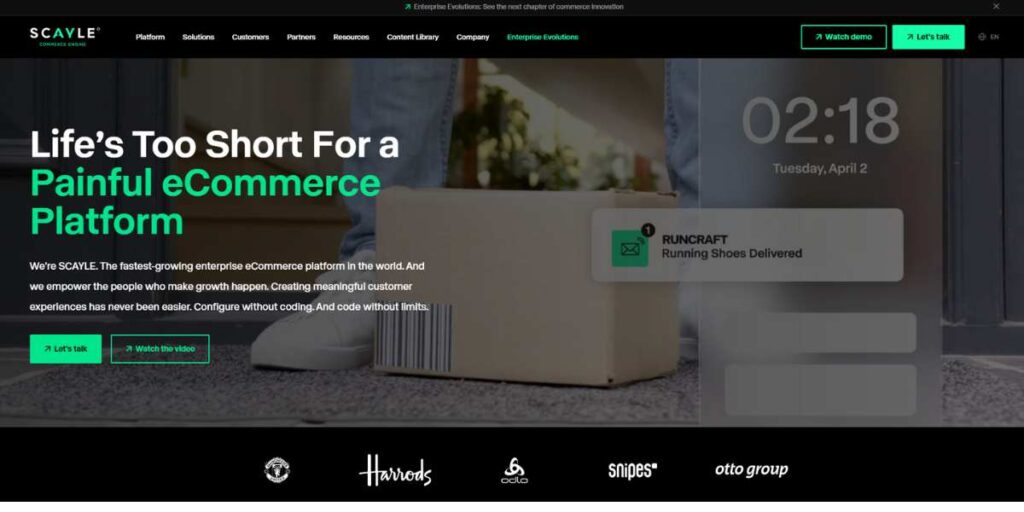
The SCAYLE (formerly AboutYou Cloud) is a latest headless commerce platform ready to supply with composable architecture and a sky-rocketed time-to-market. The add-on is a specific functionality that without which the businesses can easily develop the headless-flexible interface and a predetermined frontend that would allow you to launch it and configure in the future.
SCAYLE is going to be quite attractive to any firm planning to take its operations to international markets owing to its all-inclusive features of PIM, order administration, and internationalization. The fact that the platform focuses on the elements of flexibility and performance and the user-friendly functionality of no-code qualities allows it to be a perfect match when applied to the current instances of commerce amenities in medium to large enterprises.
Core Features:
- Built-in frontend option for rapid deployment
- Unified PIM and order management capabilities
- AI-powered search and recommendations
- Advanced promotion and segmentation tools
- Subscription management add-on
Used by: Various fashion and retail brands
Pricing: Previously starting at $5,000 per month, now custom pricing
Website: http://scayle.com
10. Intershop
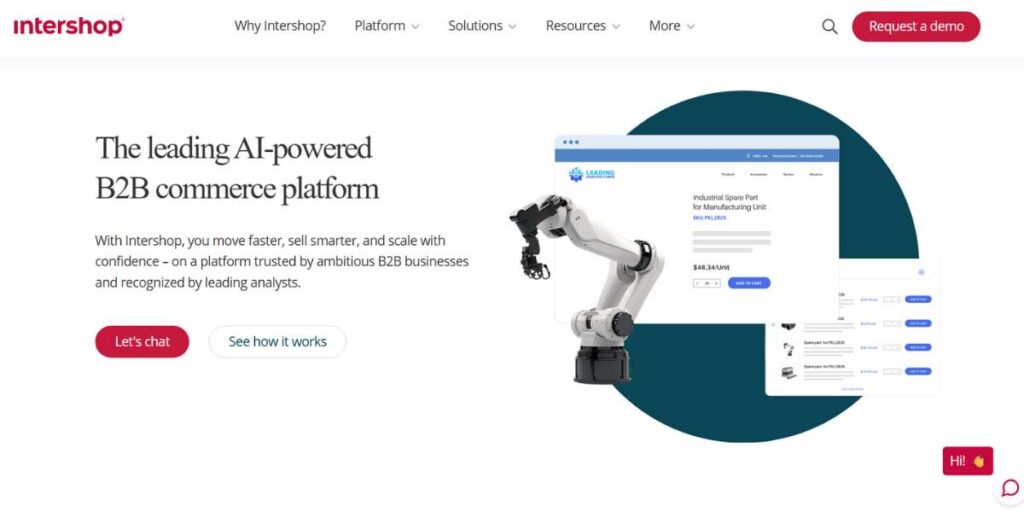
Intershop is an ecommerce application that is anchored in the B2B commerce and has over 100 APIs that are catered towards the custom ecommerce requirements of manufacturers and wholesalers. It is a multi-functional B2B portal which has integrated the headless comfort of headless commerce.
The PWA head offering in Intershop is a great way to get a business to the new front of the era quickly and the well-developed API library will enable to go all in customization and integrate whatever technology is enjoyed. It is especially helpfully because the platform is aimed to automate the sales processes and can be used to manage experience and, therefore, is especially beneficial to complex B2B functions.
Core Features:
- Progressive Web App (PWA) head for accelerated development
- Extensive API library with 100+ B2B-focused APIs
- Advanced B2B capabilities with custom approvals and catalogs
- Sales automation and workflow management
- Integrated experience management system
Used by: Manufacturing and wholesale businesses globally
Pricing: Custom pricing
Website: http://intershop.com
How to Choose the Right Headless Ecommerce Platform
- Assess Your Technical Resources: Motivate the ability of your team and decide whether you require heavy development assistance or platforms with low-code alternatives.
- Define Your Business Requirements: Identify clearly your needs such as B2B/B2C needs, International development-, scale plans, as well as integration needs with current systems.
- Consider Your Budget and Total Cost of Ownership: Consider more than just platform fees, and factor in the number of development, hosting, maintenance and third-party integration costs over time.
- Evaluate Scalability and Performance Needs: Select the platforms which will expand with your business and are not likely to lose their ability to operate under optimal performance levels because of high traffic.
- Review Integration Capabilities: Make sure that the platform integrates very well with your current technology platform made up of CRM, ERP, marketing tools, and payment processors.
- Analyze Vendor Support and Community: Examine the level of customer support, documentation, developer community and the sustainability of the vendor in the long term.
Headless Ecommerce Platform vs. Traditional Ecommerce
- Architectural Flexibility: The difference between headless and traditional e-commerce platforms is that with headless platforms, you are free to do anything with the frontend design whereas in case of traditional ones, customizations are restricted to what is provided in terms of themes and templates only.
- Development Speed: Headless platforms support parallel front-end and back-end development whereas in traditional platforms adherence to sequential steps is mandatory when developing the same.
- Scalability Options: The headless ecommerce platform supports independently scaling the frontend and the backend as opposed to the conventional platforms that are designed to scale as a monolith.
- Integration Capabilities: Headless platforms are more open with their API which allows custom integration, whereas traditional platforms usually force custom integrations to use a platform specific plugin or extension.
- Total Cost of Ownership: Headless ecommerce CMS can cost more to develop and optimize but are cheap to maintain and personalize in the long-run.
- Time to Market: Traditional platforms can be deployed with less time, and headless ecommerce platforms may need additional development in the beginning but can enable subsequent features much quicker.
Challenges of Using Headless Ecommerce
- Increased Technical Complexity: Headless commerce solutions need higher levels of technical skills to implement and maintain than the traditional solutions.
- Higher Initial Development Costs: Having to develop custom frontend development might increase investment requirements to a considerable extent.
- Integration Management: It is not always easy to coordinate various APIs and third-party integrations without organizing and documenting them.
- Security Considerations: Distributed architecture also needs thorough planning on security of different systems and locks.
- Vendor Lock-in Risks: Extensive customization can cause dependencies that complicate the migration to another platform in the future.
- Performance Optimization: The work maintaining good performance on various frontend implementations is never-ending.
Conclusion
The future of ecommerce depends on flexibility and innovation brought by the headless ecommerce platform. Since enterprises slowly gravitate toward personalized omnichannel offerings, they provide an architectural platform required to present top-tier customer experiences without compromising the business performance. The selection of the correct headless ecommerce platform should be well-thought-out, as its potential use, technical possibilities, and extension prospects must be considered. Whether your business is a start-up that wants to grow real fast or an enterprise that seeks to modernize your digital commerce capacity, the platforms recommended in this document have proved to be effective to any size of a business.
The cost of investing in headless ecommerce platforms is rewarded with higher customer experiences, quicker time-to-market of new features and agility towards the dynamic market situations. In light of the development of the e-commerce environment, the companies which implement the headless architecture will have a stronger chance to satisfy the needs and demands of their customers and achieve sustainable profit growth.
FAQs
In what sense are headless ecommerce platforms distinct to traditional ones?
Headless ecommerce systems decouple the frontend customer facing layer of the system and the backend commerce functionality, such that customer experiences can be fully customized, whilst not degrading the backend systems. Traditional platforms integrate these components, limiting customization options.
Are headless ecommerce platforms suitable for small businesses?
Headless commerce platforms have many advantages however, in general, they take more technical knowledge and advanced initial investment. Headless solutions are not the best option, and to avoid this, small businesses are expected to assess their technical resources and growth plans.
What does headless ecommerce have to say about SEO and marketing?
The headless ecommerce platforms have had great SEO options because those systems are made more attractive by using custom frontend design and API-powered content management. Several of them offer in-built SEO options and can be effectively used with marketing automation systems.
How much does headless ecommerce platforms cost to use constantly?
Headless ecommerce can include future development, hosting, maintenance and integration costs with third parties outside platform license fees. Nonetheless, such platforms tend to have a higher long-term usefulness with less customization and scaling expenditure.
Do businesses switch between the traditional ecommerce platforms and the headless solutions?
Yes, the migration can be done, between the traditional and headless ecommerce and should be planned. Majority of the platforms offer migration tools and services with majority relying on previous customizations and integrations to determine the complexity of the migration process.

